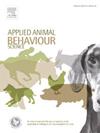我们还记得吗?空间记忆任务中绵羊和其他家畜觅食行为的比较
IF 2.2
2区 农林科学
Q1 AGRICULTURE, DAIRY & ANIMAL SCIENCE
引用次数: 0
摘要
觅食策略从根本上与资源可利用性和饮食偏好有关。适应性摄食行为,如导航到食物地点时空间记忆的作用,在野生觅食物种中被发现。我们假设驯化家畜也具有适应性觅食,由于觅食策略的不同,这种能力可能存在种间差异。因此,本研究旨在比较具有不同饮食偏好和背景的牲畜(绵羊(Ovis aries)、山羊(Capra hircus)和羊驼(Vicugna pacos))的觅食行为,以及它们记忆和优先考虑不同价值食物地点的能力。共进行了705个试验,包括一般训练、标准训练和测试试验。18只绵羊、10只山羊和7只羊驼分别拿着8个相同的水桶,放在4个交叉的底座上,分别放在测试场地的四个角落。在适应环境和训练之后,研究对象被要求在竞技场中寻找两个随机的诱饵桶,每个桶中都有大食物奖励或小食物奖励。在找到奖励后,动物们重新进入竞技场,并被要求重新放置相同的桶(实验1)。每次试验中,每个受试者最多允许两次错误地访问没有诱饵的桶,并且试验继续进行,直到两个诱饵都被吃掉或7 分钟的不活动时间过去(超过两次错误导致单个试验的“失败”得分)。然后重复这些条件,除了允许动物在初始搜索后返回竞技场后在大奖励或小奖励之间进行一次选择(实验2)。山羊在所有三个物种中通过了最多的试验(p <; 0.001),并且在两个实验中的训练和测试试验中,在重新放置诱饵桶时出错更少(p <; 0.05和p <; 0.01)。相比之下,除了一只羊驼外,其他羊驼都没有通过训练标准,主要原因是超过了不活动的时间限制。在两个实验中,我们发现不同物种对更大食物量的偏好没有显著差异(p = 0.65和p = 0.55)。同样,在所有个体中(除了一只羊,p <; 0.05,实验2),山羊的空间记忆在两种测试条件下都表现出最大的空间记忆,这可能反映了山羊在复杂的自然栖息地中导航斑状分布所需的适应性觅食策略。我们建议进一步开展工作,以确定这些物种的选择性尺度和生境感知对放牧分布的作用。这一信息可用于预测在多物种放牧系统中如何利用觅食策略的差异来最大化牧场利用效率。本文章由计算机程序翻译,如有差异,请以英文原文为准。
Do ewe remember? Comparative foraging behaviour of sheep and alternative livestock species in a spatial memory task
Foraging strategy is fundamentally linked with resource availability and dietary preference. Adaptive feeding behaviours, such as the role of spatial memory when navigating to food sites, are found in wild foraging species. We hypothesised that domesticated livestock species also possess adaptive foraging, with potential interspecies differences in this ability resulting from variations in foraging strategy. As such, this study aimed to compare foraging behaviour, in relation to ability to remember and prioritize food sites of different value, in livestock species that have different dietary preferences and backgrounds: sheep (Ovis aries), goats (Capra hircus) and alpacas (Vicugna pacos). A total of 705 trials were conducted across general training, criterion training and test trials. Eighteen sheep, 10 goats and 7 alpacas were presented with eight identical buckets, positioned on four cross mounts, that were placed into four corners of the test arena. Following acclimation and training, the subjects were required to search the arena for two randomly baited buckets, each of the two buckets containing either the large food reward or small food reward. After locating the reward, the animals re-entered the arena and were tasked to relocate the same buckets (Experiment 1). Each subject was allowed a maximum of two incorrect visits to non-baited buckets per trial, and the trial continued until both baits had been eaten or 7 min of inactivity had passed (more than two errors resulted in a ‘failure’ score for the individual trial). These conditions were then replicated, except that the animal was allowed to make a single selection between the large or small reward following their return to the arena after the initial search (Experiment 2). The goats passed the most trials across all three species (p < 0.001) and made fewer errors when relocating the baited buckets in training and test trials across both experiments (p < 0.05 and p < 0.01, respectively). In contrast, the alpacas failed to pass the training criterion, with the exception of one individual, primarily due to exceeding the time limit for inactivity. We detected no significant difference in preference for the larger food quantity between species in either experiment (p = 0.65 and p = 0.55, respectively). Equally, selection of either quantity did not deviate from random chance across all individuals (except for a single sheep, p < 0.05, Experiment 2). Thus, goats exhibited the greatest spatial memory of the three species across both test conditions, which may reflect the adaptive foraging strategy that is required to navigate patchy distributions of browse in the complex natural habitats of this species. We recommend that further work should be carried out to determine the scale of selectivity and role of habitat perception on grazing distribution in these species. This information could be used to predict how differences in foraging strategy can be exploited to maximise pasture use efficiency in multi-species grazing systems.
求助全文
通过发布文献求助,成功后即可免费获取论文全文。
去求助
来源期刊

Applied Animal Behaviour Science
农林科学-行为科学
CiteScore
4.40
自引率
21.70%
发文量
191
审稿时长
18.1 weeks
期刊介绍:
This journal publishes relevant information on the behaviour of domesticated and utilized animals.
Topics covered include:
-Behaviour of farm, zoo and laboratory animals in relation to animal management and welfare
-Behaviour of companion animals in relation to behavioural problems, for example, in relation to the training of dogs for different purposes, in relation to behavioural problems
-Studies of the behaviour of wild animals when these studies are relevant from an applied perspective, for example in relation to wildlife management, pest management or nature conservation
-Methodological studies within relevant fields
The principal subjects are farm, companion and laboratory animals, including, of course, poultry. The journal also deals with the following animal subjects:
-Those involved in any farming system, e.g. deer, rabbits and fur-bearing animals
-Those in ANY form of confinement, e.g. zoos, safari parks and other forms of display
-Feral animals, and any animal species which impinge on farming operations, e.g. as causes of loss or damage
-Species used for hunting, recreation etc. may also be considered as acceptable subjects in some instances
-Laboratory animals, if the material relates to their behavioural requirements
 求助内容:
求助内容: 应助结果提醒方式:
应助结果提醒方式:


